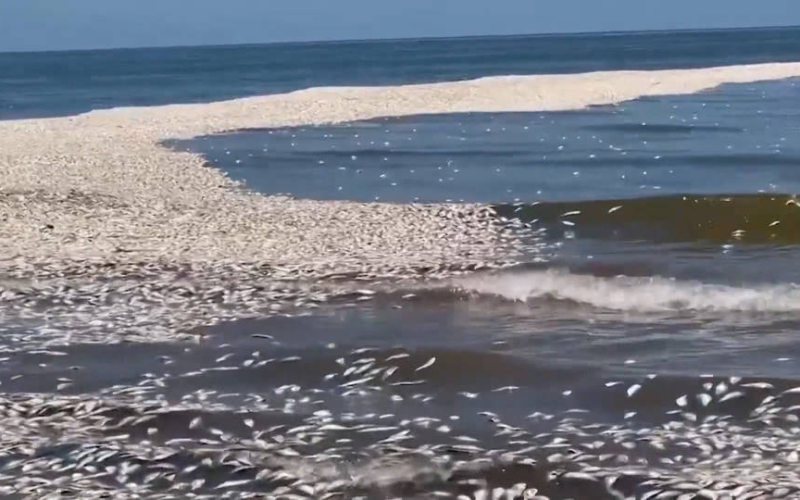Introduction
As Texas residents walked along the Gulf Coast beach this week, they were met not by gentle waves and seashells, but by thousands of lifeless fish washed ashore. The sight—and the smell—prompted an urgent response from state and local officials striving to protect public health and restore the coastline’s natural beauty. In this article, we explore what caused this massive fish kill, the health risks involved, the cleanup operations under way, and the broader environmental and economic implications. Whether you’re a coastal dweller or planning a beach trip soon, read on to learn how Texas is tackling this urgent coast cleanup effort.
1. The Scale of the Fish Kill
Early reports began on June 10, when beachgoers in Corpus Christi noticed piles of dead croaker, mullet, and drum along a three-mile stretch of sand. By June 12, local authorities estimated over 50 tons of fish had washed ashore. Nearby communities from Port Aransas to Padre Island reported similar scenes. The mass mortality spanned both public beaches and private waterfronts, disrupting tourism and local fishing charters.
Volunteers and officials counted fish in the tens of thousands, noting that smaller species and juvenile fish were especially hard hit. As the carcasses piled up in seaweed-strewn rows, the urgency to remove them became clear—not just for aesthetics, but to prevent bacterial outbreaks and noxious odors.
2. Understanding the Causes
2.1 Red Tide Algal Blooms
One leading culprit is the red tide, caused by blooms of the algae Karenia brevis. These algae produce toxins that damage fish gills, leading to mass kills. Red tide is fueled by warm water and nutrient runoff from rivers and storm drains. Satellite imagery confirmed high chlorophyll levels off the Texas coast in late May and early June, signaling a significant bloom.
2.2 Hypoxia and “Dead Zones”
Alongside red tide, low oxygen—or hypoxia—in coastal waters can suffocate fish. Decomposing algae consume oxygen, leaving too little for marine life. Seasonal temperature shifts and stagnant currents exacerbate hypoxia. The combination of toxic algae and oxygen depletion creates a lethal double threat.
2.3 Nutrient Pollution
Urban runoff, agricultural fertilizers, and wastewater discharges feed algae blooms. Nitrogen and phosphorus enter rivers during spring rains, eventually reaching the Gulf. Reducing these nutrient inputs is key to preventing future events.
3. Health Risks and Warnings
Thousands of dead fish pose several health hazards for beachgoers and residents:
- Bacterial Growth: Decomposing fish harbor Vibrio bacteria, which can cause skin infections if people wade in contaminated water.
- Air Quality Issues: Decaying fish emit hydrogen sulfide (rotten-egg smell) and ammonia, irritating eyes and lungs, especially in children, the elderly, and those with asthma.
- Toxin Exposure: Red tide toxins can aerosolize and trigger respiratory problems when sea breeze carries them ashore.
The Texas Department of State Health Services (DSHS) issued advisories: avoid contact with dead fish, wear gloves if handling is necessary, and keep children and pets away from affected areas. Officials set up temporary barriers and posted warning signs at the most impacted beaches.
4. Cleanup Efforts Under Way
4.1 State and Local Coordination
The Texas General Land Office (GLO) activated its Coastal Resilience division to coordinate with the Texas Parks and Wildlife Department (TPWD), county crews, and city sanitation workers. Their multi-agency team set priorities: first public beaches, then private shorelines.
4.2 Methods and Equipment
Cleanup crews use a combination of manual and mechanized methods:
- Manual Collection: Workers in protective gear pick up fish with shovels and buckets, placing them in biohazard bags for disposal.
- Beach Rakes and Loaders: Tractors fitted with heavy-duty rakes scoop up carcasses mixed with seaweed.
- Vactor Trucks: High-powered water vacuums and hoses flush fish into holding tanks.
- Composting and Rendering: Collected fish, once dried, are sent to industrial compost facilities or animal-feed rendering plants.
So far, over 30 cleanup operations have been completed, with more scheduled as winds shift tides and expose new hotspots.
4.3 Volunteer Involvement
Local nonprofits and community volunteers have stepped up, removing fish in early mornings and late evenings to avoid peak sun and heat. Groups like the Gulf Restoration Network supplied gloves, masks, and tools, showing how citizen action pairs with government efforts.
5. Environmental Impact
5.1 Marine Ecosystem Damage
Mass fish kills disrupt food chains. Birds and crabs feed on washed-up fish, but toxic blooms can harm these scavengers too. Juvenile fish losses threaten future population levels of game and commercial species.
5.2 Habitat Degradation
Heavy cleanup equipment can damage dunes and vegetation. Agencies work carefully to minimize disturbance, with post-cleanup dune restoration and new native plantings planned.
5.3 Long-Term Monitoring
Scientists deploy sensor buoys and conduct water sampling to track algal toxins, dissolved oxygen, and nutrient levels. Long-term data guide mitigation measures, like identifying pollution sources and forecasting future blooms.
6. Economic and Social Consequences
6.1 Tourism Decline
Texas coastal economies rely heavily on beach tourism. Hotel bookings dropped 25% in affected areas during the first weekend after the fish kill. Restaurants reported fewer foot traffic and reduced seafood orders amid safety fears.
6.2 Fishing Industry Losses
Charter and commercial fishing saw cancellations as anglers avoid toxin risks. Shrimpers and bait shops reported slow business. The Gulf of Mexico Fisheries Management Council is reviewing compensation schemes for impacted fishers.
6.3 Public Perception
Social media buzz—hashtags like #TexasDeadFish—fueled public concerns. Local chambers of commerce launched “Clean Coast” campaigns to reassure visitors and highlight unaffected beaches.
7. Preventing Future Fish Kills
7.1 Reducing Nutrient Runoff
Farmers are encouraged to adopt best management practices: buffer strips, cover crops, and precise fertilizer application. Urban planners promote green infrastructure—rain gardens and permeable pavements—to filter stormwater.
7.2 Strengthening Regulations
State lawmakers are considering tighter limits on wastewater treatment plant discharges and agricultural runoff permits. The Texas Commission on Environmental Quality (TCEQ) is reviewing enforcement strategies to ensure compliance.
7.3 Community Education
Workshops for homeowners on lawn care and pet waste management can reduce nutrient loads. Schools incorporate coastal ecology into curriculums, building awareness among the next generation.
8. Expert Perspectives
Marine biologists credit climate change for intensifying algal blooms—warmer waters speed algae growth, while stronger storms wash more nutrients ashore. Dr. Maria Hernandez of Texas A&M University notes, “Addressing fish kills requires both reducing local pollution and adapting to a changing climate.”
Coastal engineers emphasize nature-based solutions: restoring wetlands and oyster reefs to naturally filter water. Houston-based engineer James Lee explains, “Healthy wetlands can cut nutrients by 50%, lessening bloom severity before they reach open coastlines.”
Conclusion
The Texas scramble to clean the coastline after a massive fish kill highlights the complex challenges facing coastal communities. From the immediate health risks posed by decaying fish to long-term ecosystem and economic effects, the event underscores the need for integrated responses. Rapid cleanup operations—combining manual labor, machinery, and community volunteers—have restored many beaches, but the underlying causes remain. Preventing future kills demands reducing nutrient pollution, strengthening regulations, and bolstering natural filtration systems. As Texans and visitors return to the sand, they carry with them a renewed appreciation for healthy coastal waters—and the shared responsibility to protect them. By working together—government, scientists, industry, and citizens alike—we can safeguard the Gulf Coast’s rich marine life and ensure vibrant shores for generations to come.










